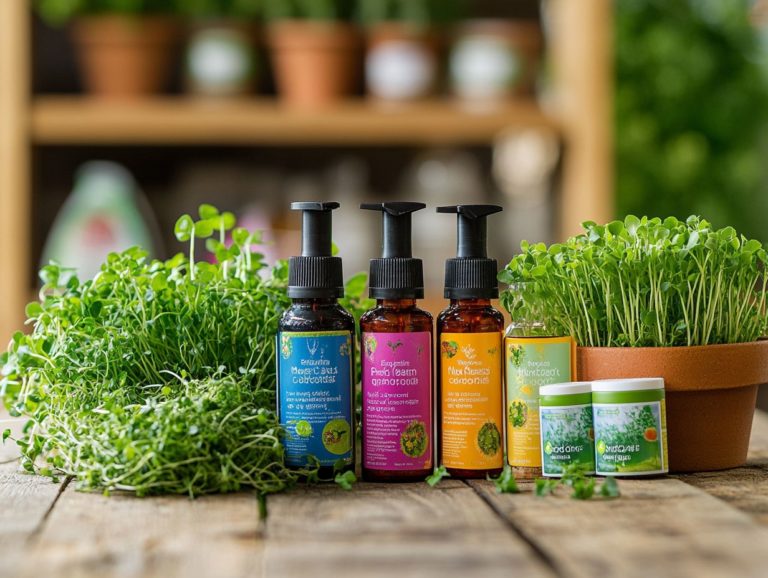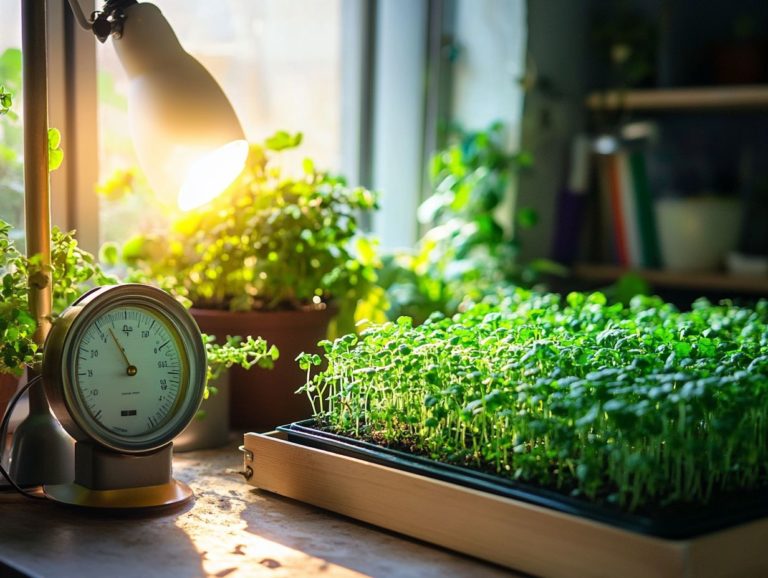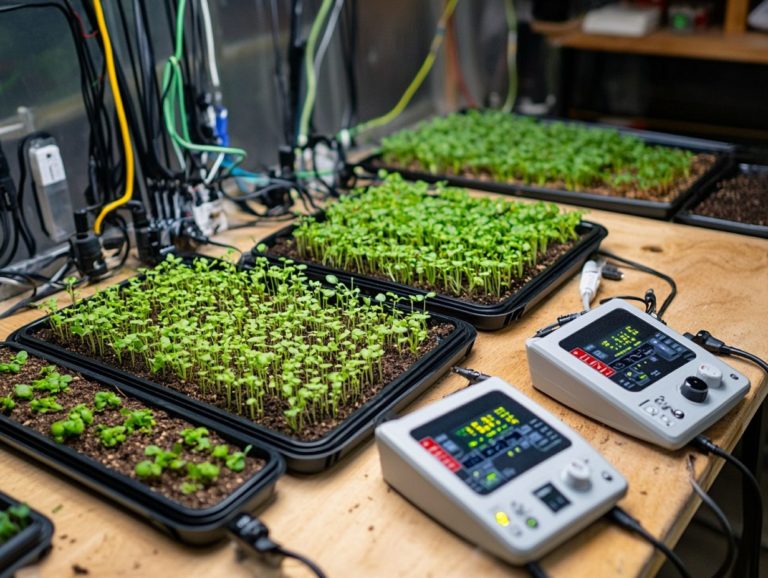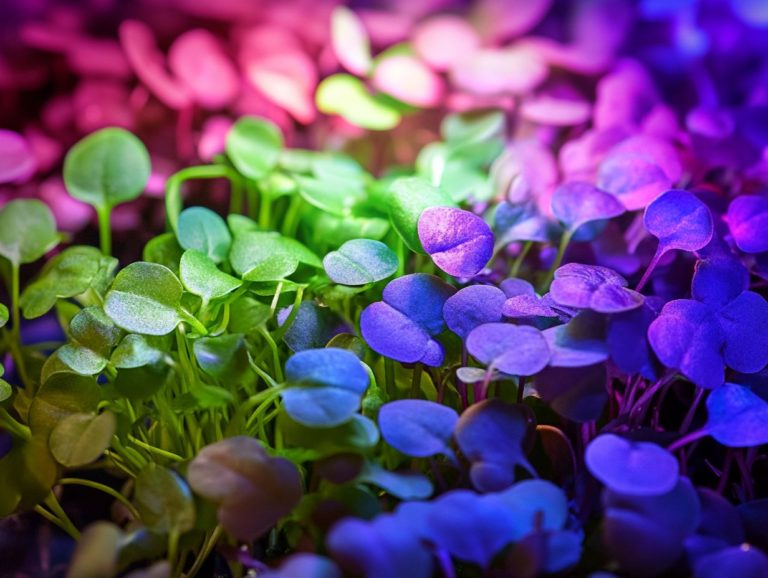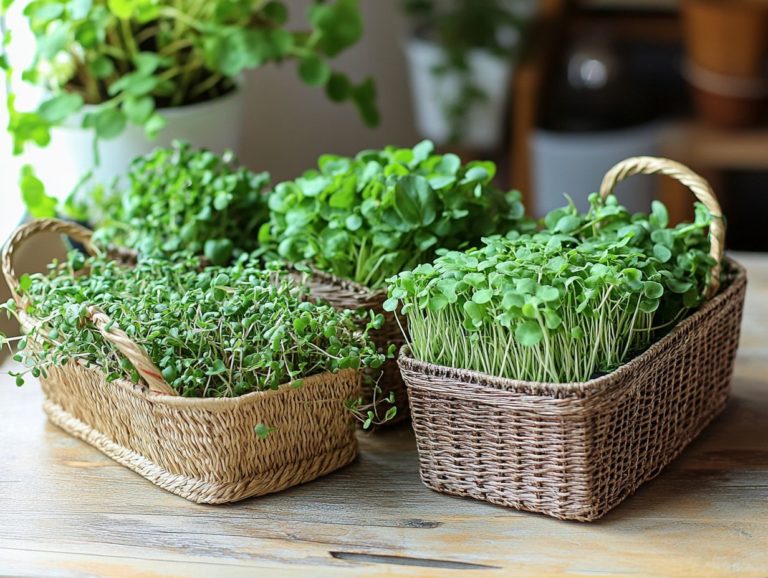Best Microgreen Harvesting Techniques Explained
Microgreens have revolutionized the culinary landscape, offering an explosion of flavor and nutrition in a compact form.
These young, edible plants are easy to cultivate and rich in vitamins and minerals, making them a remarkable enhancement to any diet. In this article, you will explore the benefits of growing and consuming microgreens, discover how to select the perfect varieties for your needs, and learn the best techniques for harvesting and storing them.
You will also find creative recipe ideas to inspire your culinary adventures. Discover why microgreens will likely be your new favorite food!
Contents
Key Takeaways:
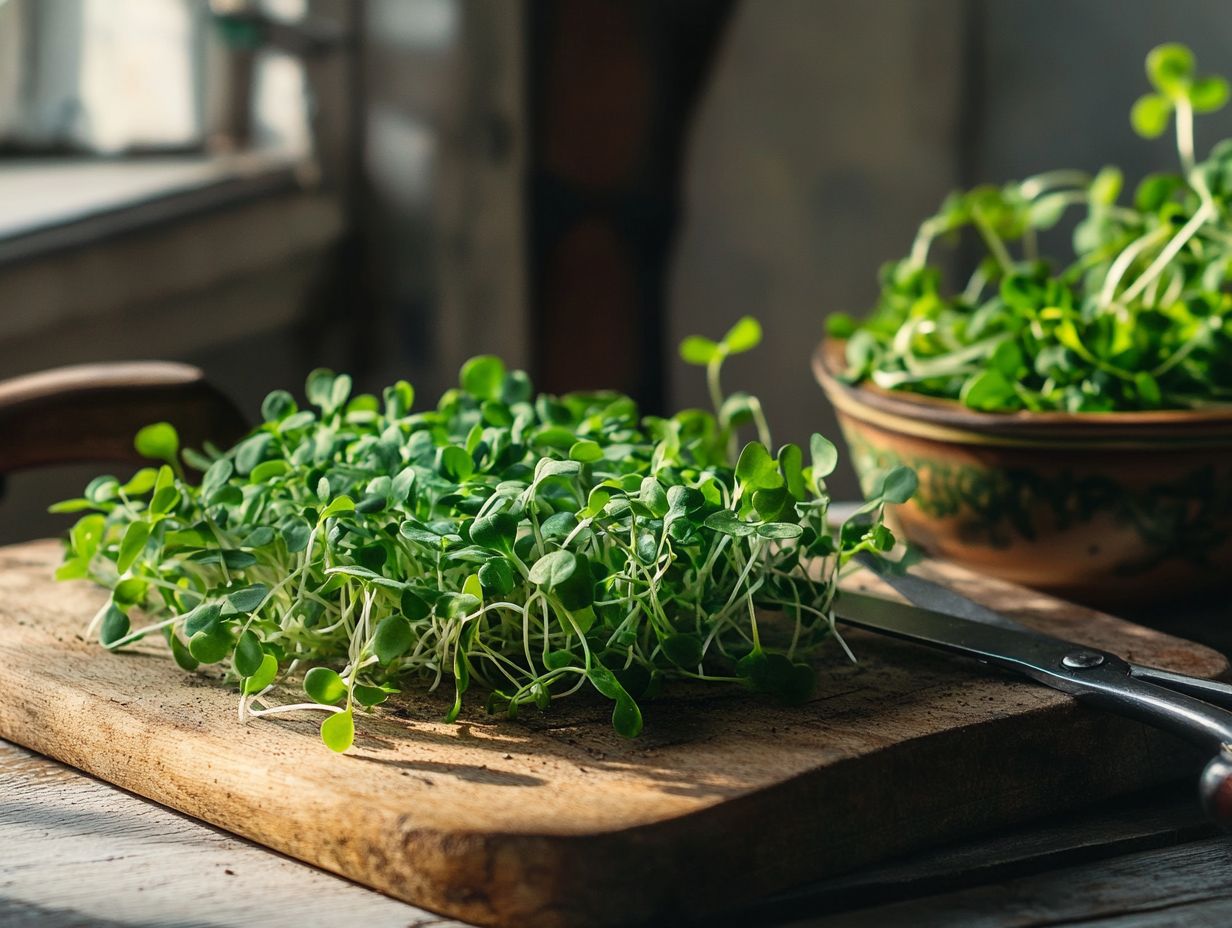
- Discover the flavor and nutrition benefits of growing and eating microgreens, packed with essential vitamins and minerals.
- Learn how to choose the right microgreens to grow and the key factors for a successful harvest.
- Maximize your harvest by knowing when to harvest and using proper tools and techniques. Explore creative ways to use microgreens in cooking.
What are Microgreens?
Microgreens are tiny, nutrient-dense greens that tantalize your taste buds and offer a wealth of health benefits. Whether you’re a culinary enthusiast or someone with a green thumb, you ll find these delicate greens irresistible.
Grown in soilless mixes, they thrive in small containers, making them perfect for growing plants in pots or small spaces. With delightful varieties like Basil Genovese, Cilantro, and Red Amaranth, the growing process is simple just soak the seeds, plant them, and watch as they flourish.
These miniature powerhouses are loaded with vitamins and antioxidants, earning their place as superfoods (foods that are exceptionally rich in nutrients). They re fantastic for container gardening, allowing anyone regardless of experience to cultivate these nutrient-rich delights indoors or on balconies.
Popular choices like Pea Shoots and Sunflower Greens not only add color to your dishes but also elevate the nutritional value of your salads and smoothies. Incorporating microgreens into your modern diet offers immense health benefits, from enhancing digestion to boosting immune function.
Using them in your meals can transform everyday dining into a vibrant and healthful experience.
Benefits of Growing and Eating Microgreens
The benefits of growing and eating microgreens are remarkable, from their exceptional nutritional density to their effortless cultivation, making them perfect for both novice and seasoned gardeners.
These petite greens do more than elevate the flavor of your dishes; they also deliver essential vitamins and minerals in a concentrated form. Embracing microgreens can transform your culinary experiences while boosting your well-being.
Nutritional Value and Flavor
Microgreens are celebrated for their remarkable nutritional density, often boasting higher levels of vitamins, minerals, and antioxidants than their mature counterparts. Their diverse flavor profiles from the peppery zing of arugula to the sweet hints of basil make them essential for any health-conscious culinary enthusiast.
These tiny greens deliver a remarkable nutrient punch, featuring vitamins C, E, and K, which enhance immune function, promote skin health, and support bone density. For instance, kale microgreens not only provide essential antioxidants but also add robust flavor to your salads and smoothies. Meanwhile, radish microgreens, known for their zesty flair, add a vibrant touch to your sandwiches and wraps.
By incorporating microgreens into your everyday meals, you can effortlessly transform your dishes while reaping the nutrients that contribute to your overall well-being.
Choosing the Right Microgreens to Grow
Selecting the perfect microgreens involves thinking about your flavor preferences, growth timelines, and unique uses for each variety. Understanding which microgreens thrive in different settings can elevate your gardening and cooking experience.
Factors to Consider

When choosing microgreens, consider your growing conditions, desired flavor, and available space. These elements help ensure your microgreens grow well and can be easily harvested.
Good lighting is crucial. Microgreens thrive in bright, indirect sunlight or under grow lights, which significantly affects their growth. Temperature is also important; most varieties need a consistent range for strong development.
Don t forget about space requirements. Small containers can host a variety of microgreens, but larger selections may need more room for their leaves to spread.
Focusing on these aspects enhances your yield and enriches the unique flavor profiles each type of microgreen brings to your dishes.
Harvesting Microgreens
Harvesting microgreens is exciting! Pay close attention for the best flavor and nutrition. Using effective harvesting techniques allows you to enjoy fresh microgreens at their best while maximizing your yield.
When to Harvest
Knowing when to harvest is key to your dishes. Microgreens typically mature in just 7 to 21 days, depending on the type. Look for true leaves and vibrant colors as signs that they are ready.
For example, mustard microgreens can be ready in just 7 to 10 days, delivering a robust flavor that many chefs love. In contrast, basil microgreens require around 14 to 21 days for optimal taste and nutrient density. Pea shoots, with their sweet and crunchy leaves, are usually ready for harvest around 10 to 14 days. Using proper watering techniques for thriving microgreens can further enhance their growth and flavor.
By observing these growth stages, you unlock maximum taste and health benefits, ensuring these delicate greens are collected at just the right moment to elevate any dish.
Tools and Techniques
To harvest microgreens effectively, use the right tools. Sharp scissors are essential for clean cuts, and suitable containers help keep them fresh. A utility knife can also be handy; cut stems just above the soil line to encourage regrowth.
Once you’ve made the cuts, transfer the microgreens into breathable containers for proper airflow. This is vital for maintaining their freshness during storage. Damp paper towels or breathable bags can help manage humidity and prevent wilting.
By handling these delicate greens with care, you ensure they retain their nutritional benefits making them a top choice for health-conscious gardeners.
Storing and Preserving Microgreens
Proper storage keeps your microgreens fresh and nutritious. Use breathable containers for airflow and damp paper towels or breathable bags to manage humidity and prevent wilting.
By employing effective storage methods, you can savor the delicate textures and vibrant colors of your microgreens longer in your meals.
Proper Storage Methods
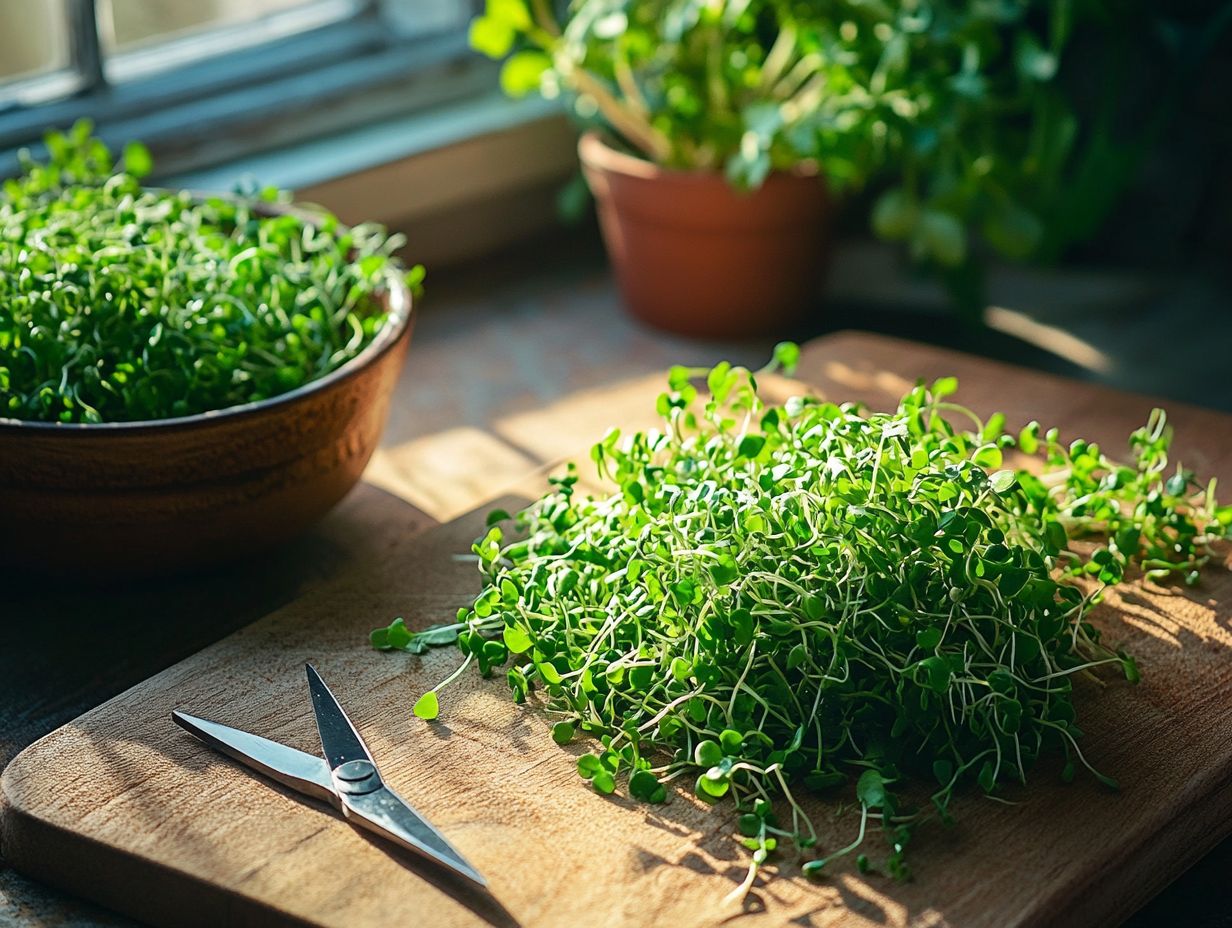
Store your microgreens in a cool, dry place. Wrap them in a damp paper towel and place them in a sealed container to keep them fresh.
Set your refrigerator temperature between 32 F and 36 F. This cool environment slows down the greens’ metabolism, helping prevent spoilage.
Maintain humidity levels between 40% and 60% to avoid wilting. You can create a mini-humidity chamber by placing a small dish of water inside the container.
Use breathable bags or containers designed for leafy greens. This allows air circulation while keeping moisture, helping your microgreens stay vibrant and flavorful.
Creative Ways to Use Microgreens in Cooking
Microgreens are a delightful ingredient for cooking lovers, delivering a burst of flavor and nutrition to various dishes.
Whether you re crafting a vibrant salad or enhancing a garnish, there are endless ways to incorporate these delicate greens into your meals, elevating both taste and visual appeal.
Recipes and Ideas
Integrating microgreens into your cooking opens up a world of flavors and textures. Consider using microgreens like Radish or Arugula to elevate your dishes.
You can incorporate them into salads or sandwiches, or use them as garnishes for an enhanced flavor profile.
These vibrant greens add color and bring unique tastes and nutritional benefits that can transform even the simplest recipes. For instance, Radish microgreens are peppery and deliver a delightful kick to classic tuna salad.
Arugula microgreens add slightly bitter notes to creamy pasta, balancing richness with freshness. Pea Shoots offer a sweet, crisp crunch, perfect for topping savory quiche or blending into pesto for a green twist.
Each type of microgreen infuses your dishes with character, allowing you to impress diners with minimal effort.
Frequently Asked Questions
What are microgreens?
Microgreens are young vegetable greens harvested after the first true leaves have developed. They are smaller than baby greens and larger than sprouts.
Why are microgreens becoming popular?
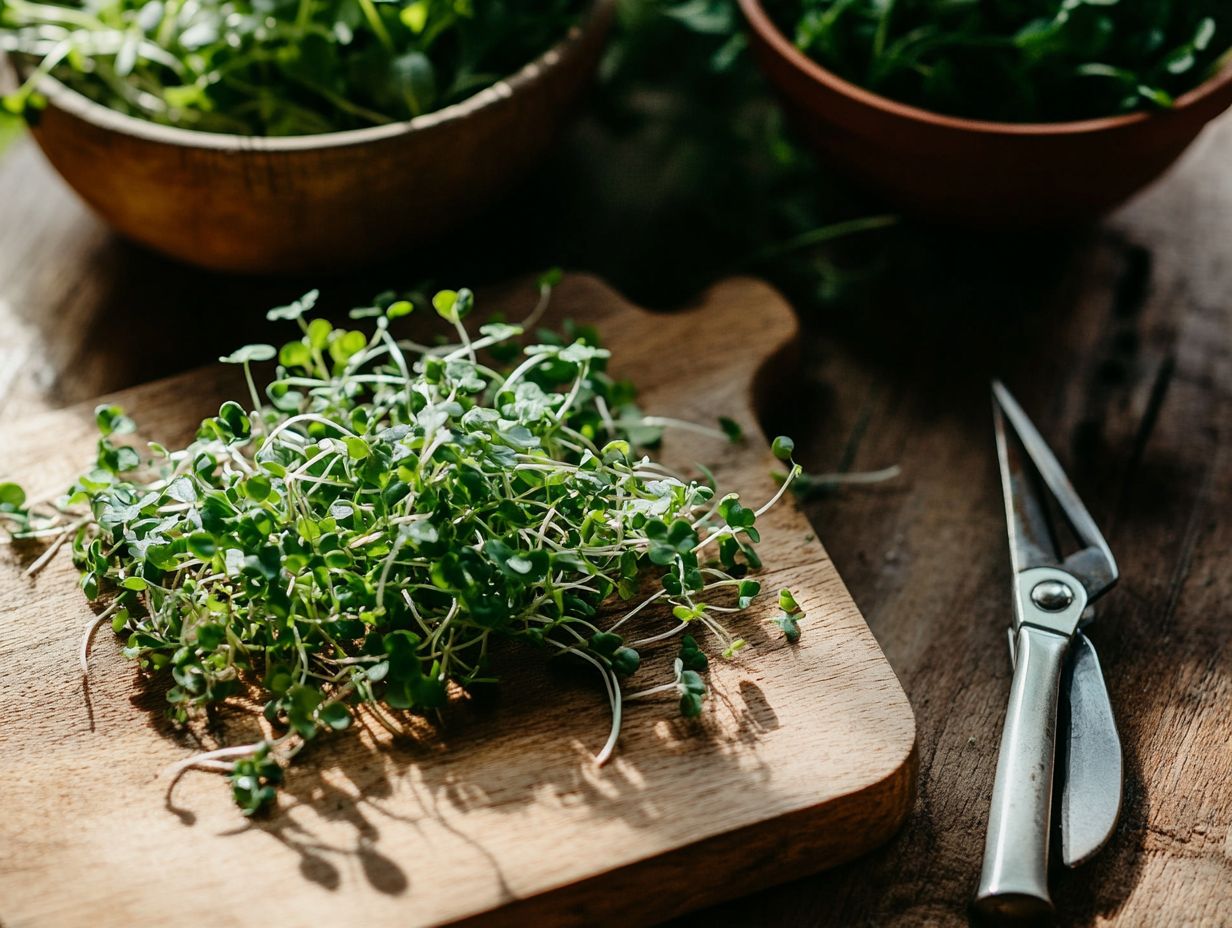
Microgreens are taking the culinary world by storm! They are packed with nutrients, easy to grow, and come in a variety of flavors and textures.
How do I know when my microgreens are ready to harvest?
Microgreens are usually ready to harvest when their first set of true leaves has developed, typically around 1-3 weeks after planting.
What are the best techniques for harvesting microgreens?
The best technique for harvesting microgreens is to use a sharp pair of scissors or a clean knife to cut the stems just above the soil level. Avoid pulling them out of the soil, as this can damage the roots and affect future growth.
Should I harvest my microgreens all at once or in batches?
It is recommended to harvest microgreens in batches, starting with the outer edges of the container and leaving the center plants to continue growing. This allows for multiple harvests from the same batch.
How should I store harvested microgreens?
Harvested microgreens should be stored in an airtight container or plastic bag in the refrigerator. They can stay fresh for up to a week, but it is best to consume them as soon as possible for maximum flavor and nutrition.

